Patisserie: A Comparison of Traditional and Contemporary Practices with a Focus on Brioche
VerifiedAdded on 2023/06/12
|9
|2178
|152
AI Summary
This report explores the history and evolution of patisserie practices with a focus on Brioche. It compares and contrasts traditional and contemporary practices, and discusses the influence of market forces and consumer demand. The report also includes information on the prevalence of artisan and industrial patisserie practices in different countries, and the turnover of the patisserie industry in Europe.
Contribute Materials
Your contribution can guide someone’s learning journey. Share your
documents today.
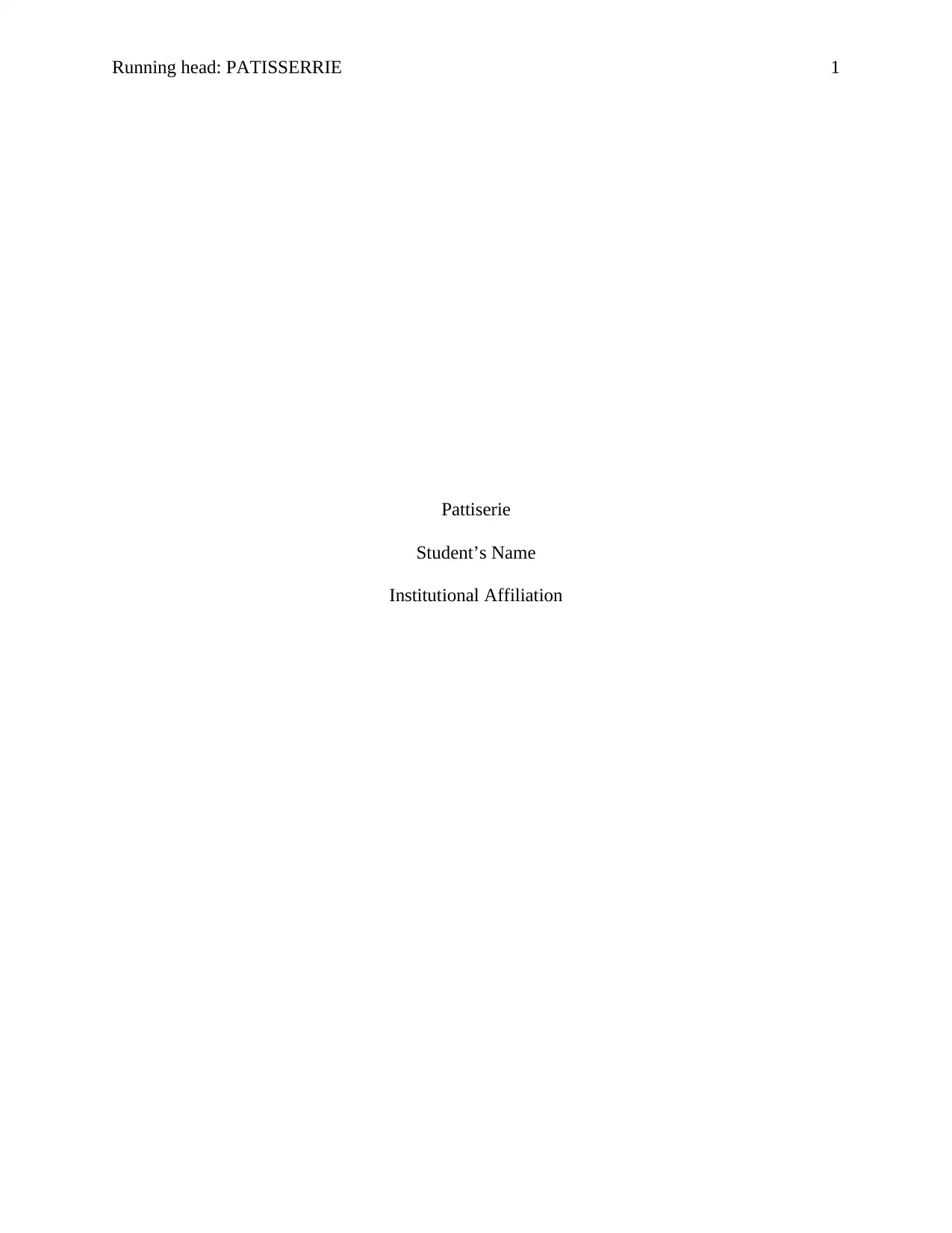
Running head: PATISSERRIE 1
Pattiserie
Student’s Name
Institutional Affiliation
Pattiserie
Student’s Name
Institutional Affiliation
Secure Best Marks with AI Grader
Need help grading? Try our AI Grader for instant feedback on your assignments.
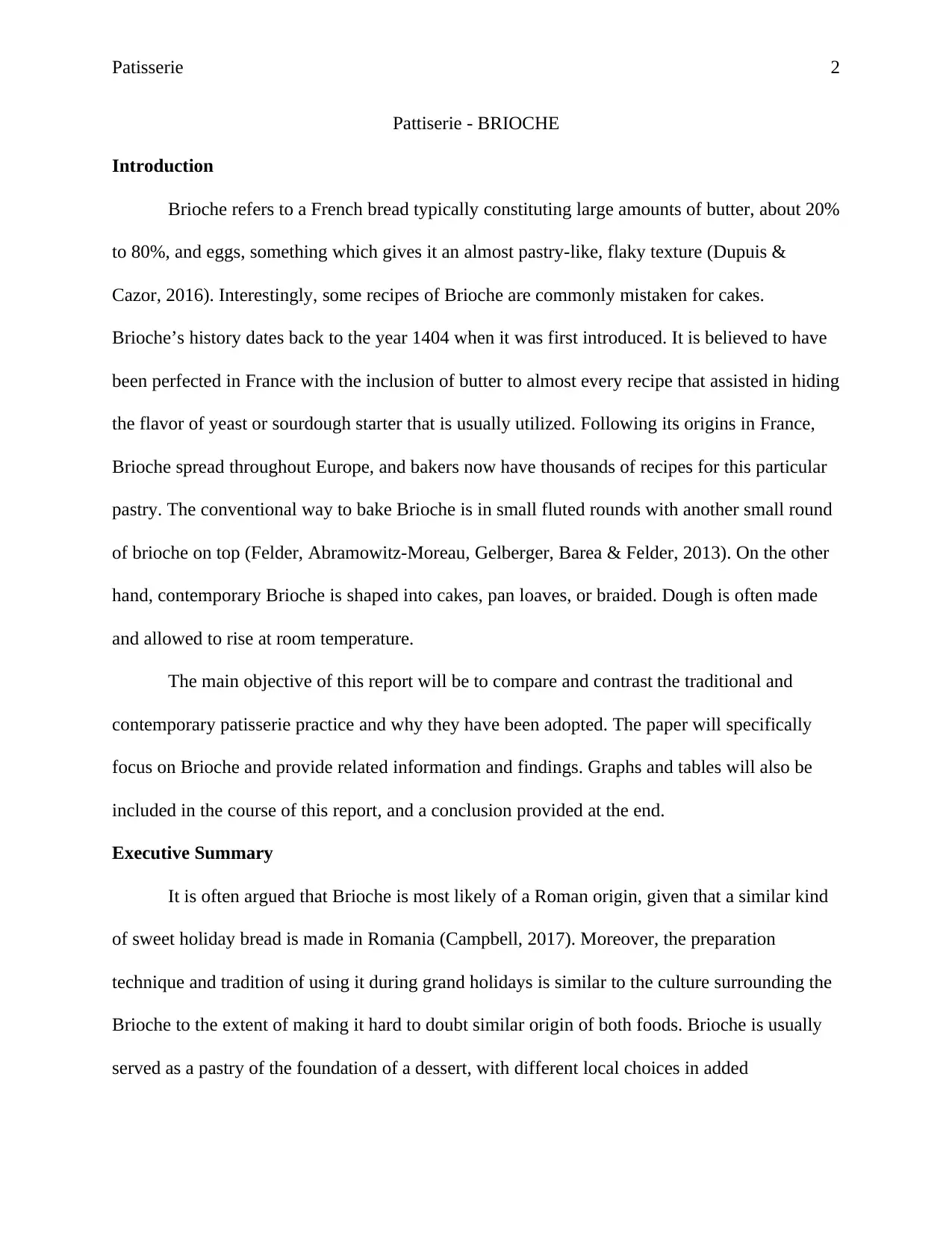
Patisserie 2
Pattiserie - BRIOCHE
Introduction
Brioche refers to a French bread typically constituting large amounts of butter, about 20%
to 80%, and eggs, something which gives it an almost pastry-like, flaky texture (Dupuis &
Cazor, 2016). Interestingly, some recipes of Brioche are commonly mistaken for cakes.
Brioche’s history dates back to the year 1404 when it was first introduced. It is believed to have
been perfected in France with the inclusion of butter to almost every recipe that assisted in hiding
the flavor of yeast or sourdough starter that is usually utilized. Following its origins in France,
Brioche spread throughout Europe, and bakers now have thousands of recipes for this particular
pastry. The conventional way to bake Brioche is in small fluted rounds with another small round
of brioche on top (Felder, Abramowitz-Moreau, Gelberger, Barea & Felder, 2013). On the other
hand, contemporary Brioche is shaped into cakes, pan loaves, or braided. Dough is often made
and allowed to rise at room temperature.
The main objective of this report will be to compare and contrast the traditional and
contemporary patisserie practice and why they have been adopted. The paper will specifically
focus on Brioche and provide related information and findings. Graphs and tables will also be
included in the course of this report, and a conclusion provided at the end.
Executive Summary
It is often argued that Brioche is most likely of a Roman origin, given that a similar kind
of sweet holiday bread is made in Romania (Campbell, 2017). Moreover, the preparation
technique and tradition of using it during grand holidays is similar to the culture surrounding the
Brioche to the extent of making it hard to doubt similar origin of both foods. Brioche is usually
served as a pastry of the foundation of a dessert, with different local choices in added
Pattiserie - BRIOCHE
Introduction
Brioche refers to a French bread typically constituting large amounts of butter, about 20%
to 80%, and eggs, something which gives it an almost pastry-like, flaky texture (Dupuis &
Cazor, 2016). Interestingly, some recipes of Brioche are commonly mistaken for cakes.
Brioche’s history dates back to the year 1404 when it was first introduced. It is believed to have
been perfected in France with the inclusion of butter to almost every recipe that assisted in hiding
the flavor of yeast or sourdough starter that is usually utilized. Following its origins in France,
Brioche spread throughout Europe, and bakers now have thousands of recipes for this particular
pastry. The conventional way to bake Brioche is in small fluted rounds with another small round
of brioche on top (Felder, Abramowitz-Moreau, Gelberger, Barea & Felder, 2013). On the other
hand, contemporary Brioche is shaped into cakes, pan loaves, or braided. Dough is often made
and allowed to rise at room temperature.
The main objective of this report will be to compare and contrast the traditional and
contemporary patisserie practice and why they have been adopted. The paper will specifically
focus on Brioche and provide related information and findings. Graphs and tables will also be
included in the course of this report, and a conclusion provided at the end.
Executive Summary
It is often argued that Brioche is most likely of a Roman origin, given that a similar kind
of sweet holiday bread is made in Romania (Campbell, 2017). Moreover, the preparation
technique and tradition of using it during grand holidays is similar to the culture surrounding the
Brioche to the extent of making it hard to doubt similar origin of both foods. Brioche is usually
served as a pastry of the foundation of a dessert, with different local choices in added
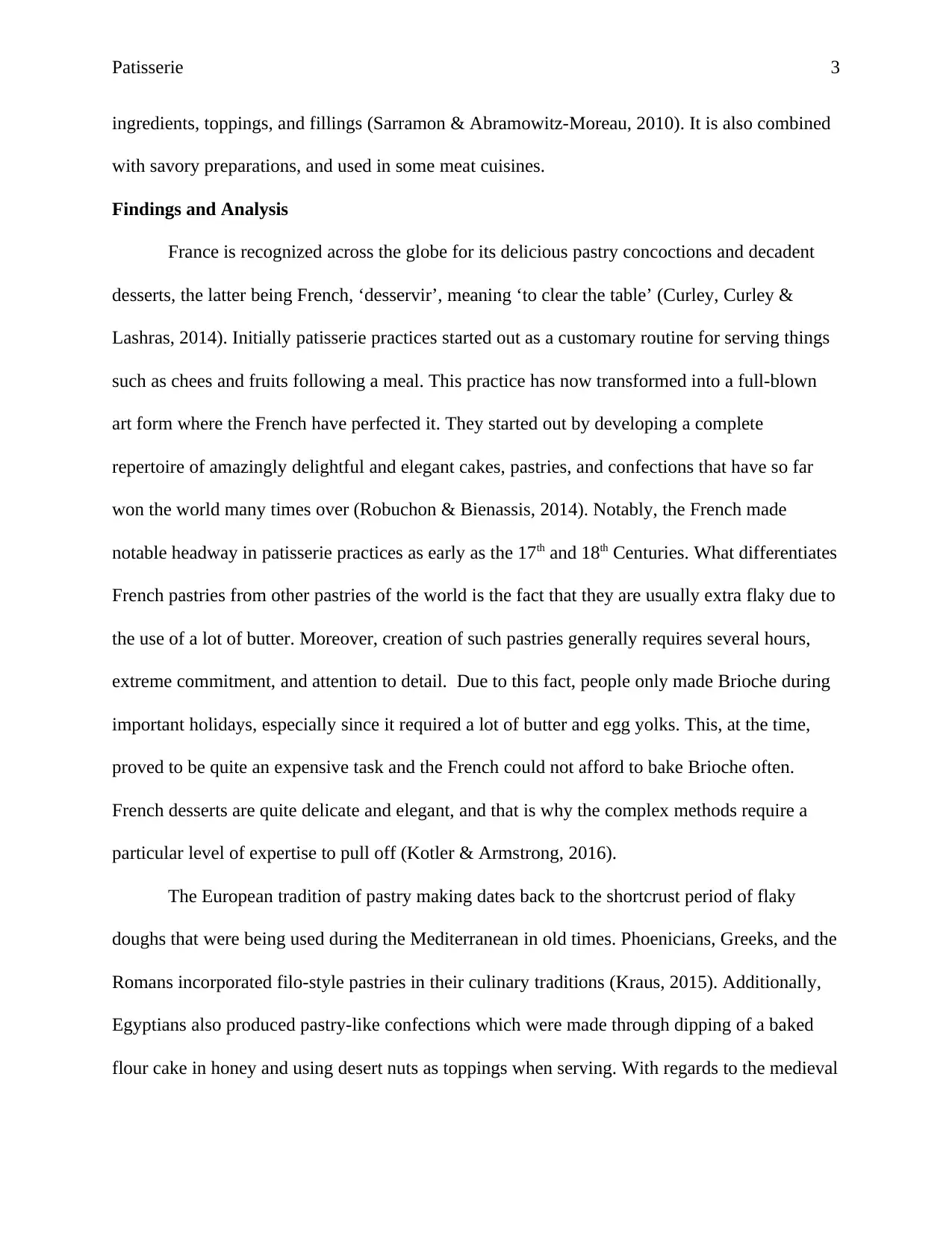
Patisserie 3
ingredients, toppings, and fillings (Sarramon & Abramowitz-Moreau, 2010). It is also combined
with savory preparations, and used in some meat cuisines.
Findings and Analysis
France is recognized across the globe for its delicious pastry concoctions and decadent
desserts, the latter being French, ‘desservir’, meaning ‘to clear the table’ (Curley, Curley &
Lashras, 2014). Initially patisserie practices started out as a customary routine for serving things
such as chees and fruits following a meal. This practice has now transformed into a full-blown
art form where the French have perfected it. They started out by developing a complete
repertoire of amazingly delightful and elegant cakes, pastries, and confections that have so far
won the world many times over (Robuchon & Bienassis, 2014). Notably, the French made
notable headway in patisserie practices as early as the 17th and 18th Centuries. What differentiates
French pastries from other pastries of the world is the fact that they are usually extra flaky due to
the use of a lot of butter. Moreover, creation of such pastries generally requires several hours,
extreme commitment, and attention to detail. Due to this fact, people only made Brioche during
important holidays, especially since it required a lot of butter and egg yolks. This, at the time,
proved to be quite an expensive task and the French could not afford to bake Brioche often.
French desserts are quite delicate and elegant, and that is why the complex methods require a
particular level of expertise to pull off (Kotler & Armstrong, 2016).
The European tradition of pastry making dates back to the shortcrust period of flaky
doughs that were being used during the Mediterranean in old times. Phoenicians, Greeks, and the
Romans incorporated filo-style pastries in their culinary traditions (Kraus, 2015). Additionally,
Egyptians also produced pastry-like confections which were made through dipping of a baked
flour cake in honey and using desert nuts as toppings when serving. With regards to the medieval
ingredients, toppings, and fillings (Sarramon & Abramowitz-Moreau, 2010). It is also combined
with savory preparations, and used in some meat cuisines.
Findings and Analysis
France is recognized across the globe for its delicious pastry concoctions and decadent
desserts, the latter being French, ‘desservir’, meaning ‘to clear the table’ (Curley, Curley &
Lashras, 2014). Initially patisserie practices started out as a customary routine for serving things
such as chees and fruits following a meal. This practice has now transformed into a full-blown
art form where the French have perfected it. They started out by developing a complete
repertoire of amazingly delightful and elegant cakes, pastries, and confections that have so far
won the world many times over (Robuchon & Bienassis, 2014). Notably, the French made
notable headway in patisserie practices as early as the 17th and 18th Centuries. What differentiates
French pastries from other pastries of the world is the fact that they are usually extra flaky due to
the use of a lot of butter. Moreover, creation of such pastries generally requires several hours,
extreme commitment, and attention to detail. Due to this fact, people only made Brioche during
important holidays, especially since it required a lot of butter and egg yolks. This, at the time,
proved to be quite an expensive task and the French could not afford to bake Brioche often.
French desserts are quite delicate and elegant, and that is why the complex methods require a
particular level of expertise to pull off (Kotler & Armstrong, 2016).
The European tradition of pastry making dates back to the shortcrust period of flaky
doughs that were being used during the Mediterranean in old times. Phoenicians, Greeks, and the
Romans incorporated filo-style pastries in their culinary traditions (Kraus, 2015). Additionally,
Egyptians also produced pastry-like confections which were made through dipping of a baked
flour cake in honey and using desert nuts as toppings when serving. With regards to the medieval
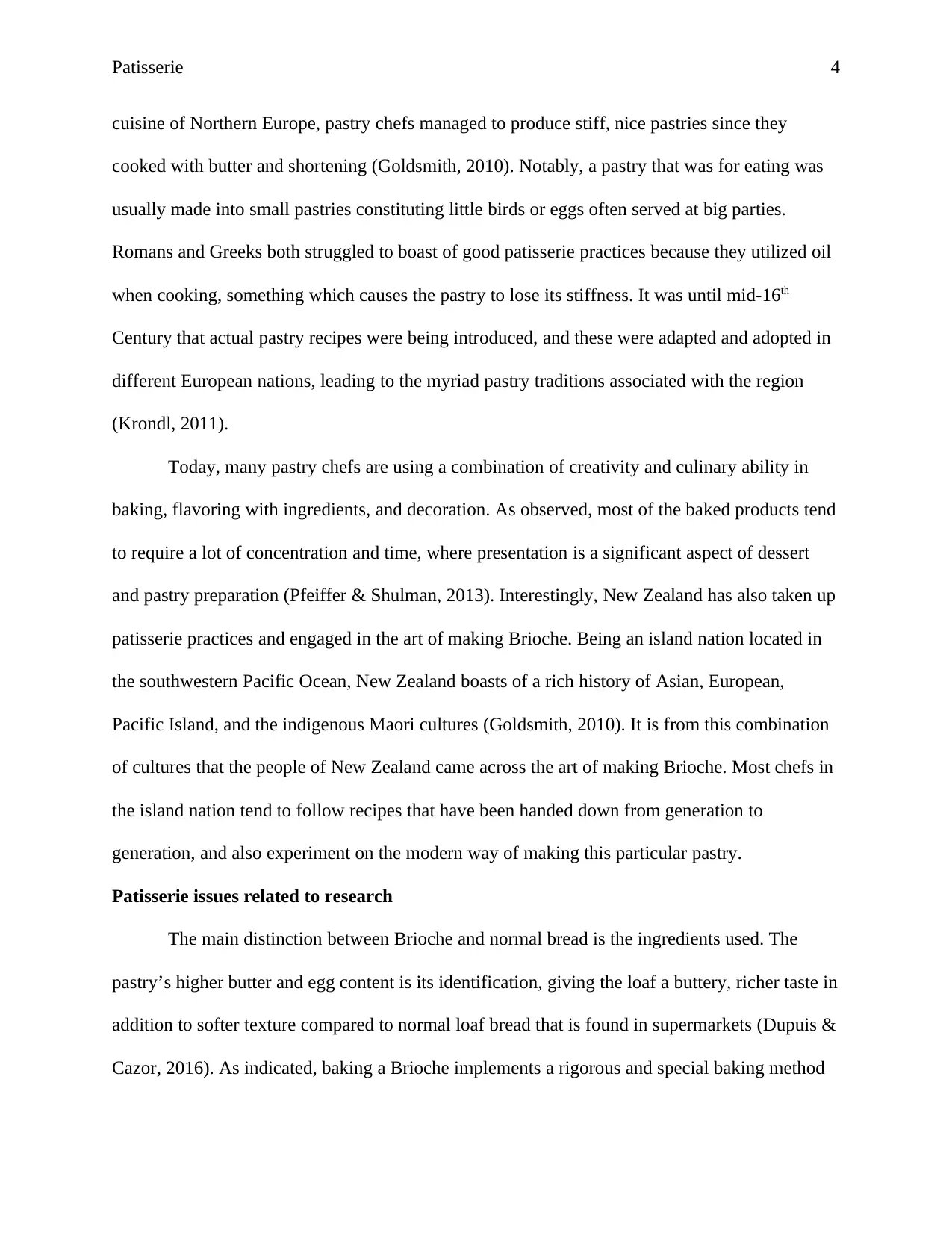
Patisserie 4
cuisine of Northern Europe, pastry chefs managed to produce stiff, nice pastries since they
cooked with butter and shortening (Goldsmith, 2010). Notably, a pastry that was for eating was
usually made into small pastries constituting little birds or eggs often served at big parties.
Romans and Greeks both struggled to boast of good patisserie practices because they utilized oil
when cooking, something which causes the pastry to lose its stiffness. It was until mid-16th
Century that actual pastry recipes were being introduced, and these were adapted and adopted in
different European nations, leading to the myriad pastry traditions associated with the region
(Krondl, 2011).
Today, many pastry chefs are using a combination of creativity and culinary ability in
baking, flavoring with ingredients, and decoration. As observed, most of the baked products tend
to require a lot of concentration and time, where presentation is a significant aspect of dessert
and pastry preparation (Pfeiffer & Shulman, 2013). Interestingly, New Zealand has also taken up
patisserie practices and engaged in the art of making Brioche. Being an island nation located in
the southwestern Pacific Ocean, New Zealand boasts of a rich history of Asian, European,
Pacific Island, and the indigenous Maori cultures (Goldsmith, 2010). It is from this combination
of cultures that the people of New Zealand came across the art of making Brioche. Most chefs in
the island nation tend to follow recipes that have been handed down from generation to
generation, and also experiment on the modern way of making this particular pastry.
Patisserie issues related to research
The main distinction between Brioche and normal bread is the ingredients used. The
pastry’s higher butter and egg content is its identification, giving the loaf a buttery, richer taste in
addition to softer texture compared to normal loaf bread that is found in supermarkets (Dupuis &
Cazor, 2016). As indicated, baking a Brioche implements a rigorous and special baking method
cuisine of Northern Europe, pastry chefs managed to produce stiff, nice pastries since they
cooked with butter and shortening (Goldsmith, 2010). Notably, a pastry that was for eating was
usually made into small pastries constituting little birds or eggs often served at big parties.
Romans and Greeks both struggled to boast of good patisserie practices because they utilized oil
when cooking, something which causes the pastry to lose its stiffness. It was until mid-16th
Century that actual pastry recipes were being introduced, and these were adapted and adopted in
different European nations, leading to the myriad pastry traditions associated with the region
(Krondl, 2011).
Today, many pastry chefs are using a combination of creativity and culinary ability in
baking, flavoring with ingredients, and decoration. As observed, most of the baked products tend
to require a lot of concentration and time, where presentation is a significant aspect of dessert
and pastry preparation (Pfeiffer & Shulman, 2013). Interestingly, New Zealand has also taken up
patisserie practices and engaged in the art of making Brioche. Being an island nation located in
the southwestern Pacific Ocean, New Zealand boasts of a rich history of Asian, European,
Pacific Island, and the indigenous Maori cultures (Goldsmith, 2010). It is from this combination
of cultures that the people of New Zealand came across the art of making Brioche. Most chefs in
the island nation tend to follow recipes that have been handed down from generation to
generation, and also experiment on the modern way of making this particular pastry.
Patisserie issues related to research
The main distinction between Brioche and normal bread is the ingredients used. The
pastry’s higher butter and egg content is its identification, giving the loaf a buttery, richer taste in
addition to softer texture compared to normal loaf bread that is found in supermarkets (Dupuis &
Cazor, 2016). As indicated, baking a Brioche implements a rigorous and special baking method
Secure Best Marks with AI Grader
Need help grading? Try our AI Grader for instant feedback on your assignments.
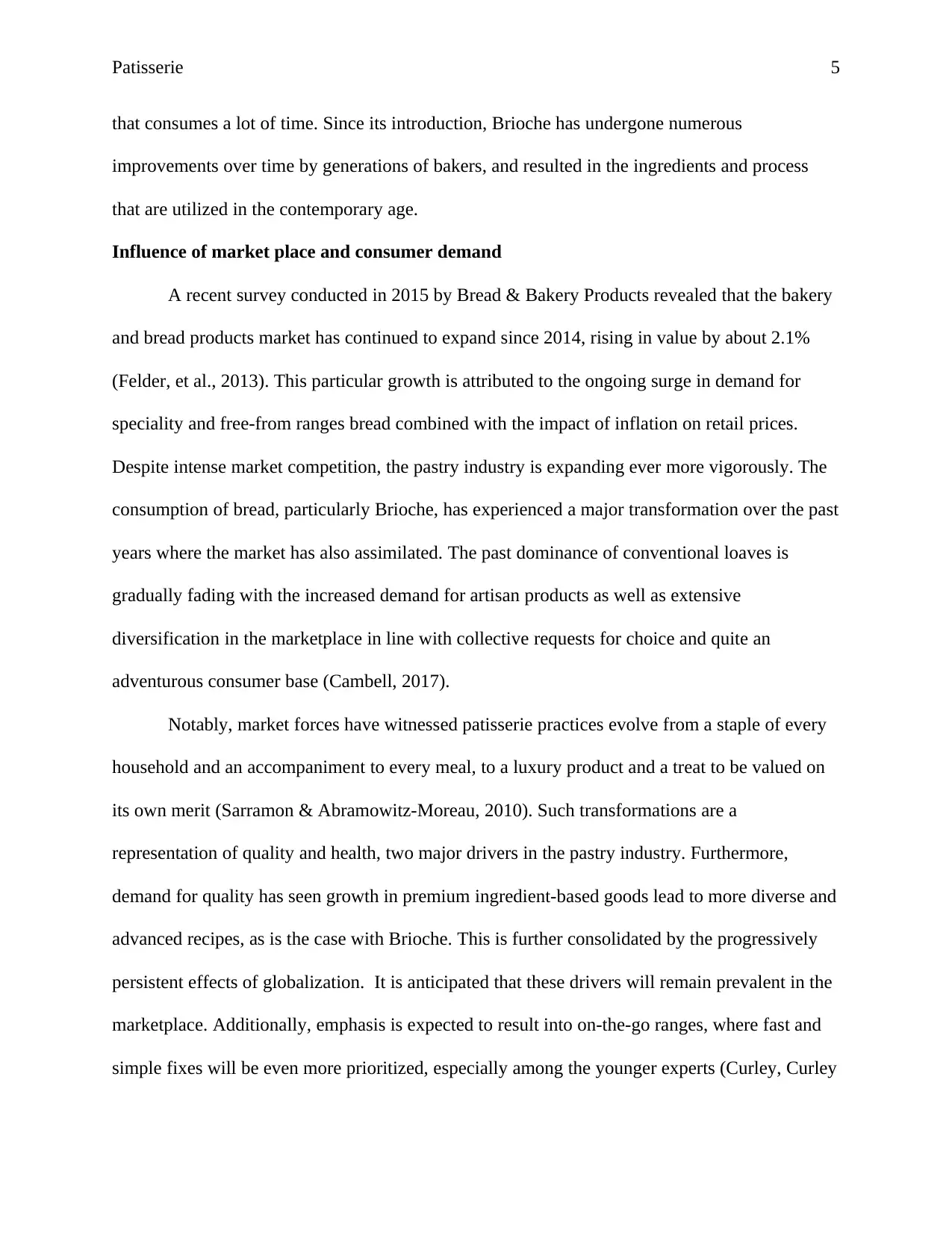
Patisserie 5
that consumes a lot of time. Since its introduction, Brioche has undergone numerous
improvements over time by generations of bakers, and resulted in the ingredients and process
that are utilized in the contemporary age.
Influence of market place and consumer demand
A recent survey conducted in 2015 by Bread & Bakery Products revealed that the bakery
and bread products market has continued to expand since 2014, rising in value by about 2.1%
(Felder, et al., 2013). This particular growth is attributed to the ongoing surge in demand for
speciality and free-from ranges bread combined with the impact of inflation on retail prices.
Despite intense market competition, the pastry industry is expanding ever more vigorously. The
consumption of bread, particularly Brioche, has experienced a major transformation over the past
years where the market has also assimilated. The past dominance of conventional loaves is
gradually fading with the increased demand for artisan products as well as extensive
diversification in the marketplace in line with collective requests for choice and quite an
adventurous consumer base (Cambell, 2017).
Notably, market forces have witnessed patisserie practices evolve from a staple of every
household and an accompaniment to every meal, to a luxury product and a treat to be valued on
its own merit (Sarramon & Abramowitz-Moreau, 2010). Such transformations are a
representation of quality and health, two major drivers in the pastry industry. Furthermore,
demand for quality has seen growth in premium ingredient-based goods lead to more diverse and
advanced recipes, as is the case with Brioche. This is further consolidated by the progressively
persistent effects of globalization. It is anticipated that these drivers will remain prevalent in the
marketplace. Additionally, emphasis is expected to result into on-the-go ranges, where fast and
simple fixes will be even more prioritized, especially among the younger experts (Curley, Curley
that consumes a lot of time. Since its introduction, Brioche has undergone numerous
improvements over time by generations of bakers, and resulted in the ingredients and process
that are utilized in the contemporary age.
Influence of market place and consumer demand
A recent survey conducted in 2015 by Bread & Bakery Products revealed that the bakery
and bread products market has continued to expand since 2014, rising in value by about 2.1%
(Felder, et al., 2013). This particular growth is attributed to the ongoing surge in demand for
speciality and free-from ranges bread combined with the impact of inflation on retail prices.
Despite intense market competition, the pastry industry is expanding ever more vigorously. The
consumption of bread, particularly Brioche, has experienced a major transformation over the past
years where the market has also assimilated. The past dominance of conventional loaves is
gradually fading with the increased demand for artisan products as well as extensive
diversification in the marketplace in line with collective requests for choice and quite an
adventurous consumer base (Cambell, 2017).
Notably, market forces have witnessed patisserie practices evolve from a staple of every
household and an accompaniment to every meal, to a luxury product and a treat to be valued on
its own merit (Sarramon & Abramowitz-Moreau, 2010). Such transformations are a
representation of quality and health, two major drivers in the pastry industry. Furthermore,
demand for quality has seen growth in premium ingredient-based goods lead to more diverse and
advanced recipes, as is the case with Brioche. This is further consolidated by the progressively
persistent effects of globalization. It is anticipated that these drivers will remain prevalent in the
marketplace. Additionally, emphasis is expected to result into on-the-go ranges, where fast and
simple fixes will be even more prioritized, especially among the younger experts (Curley, Curley
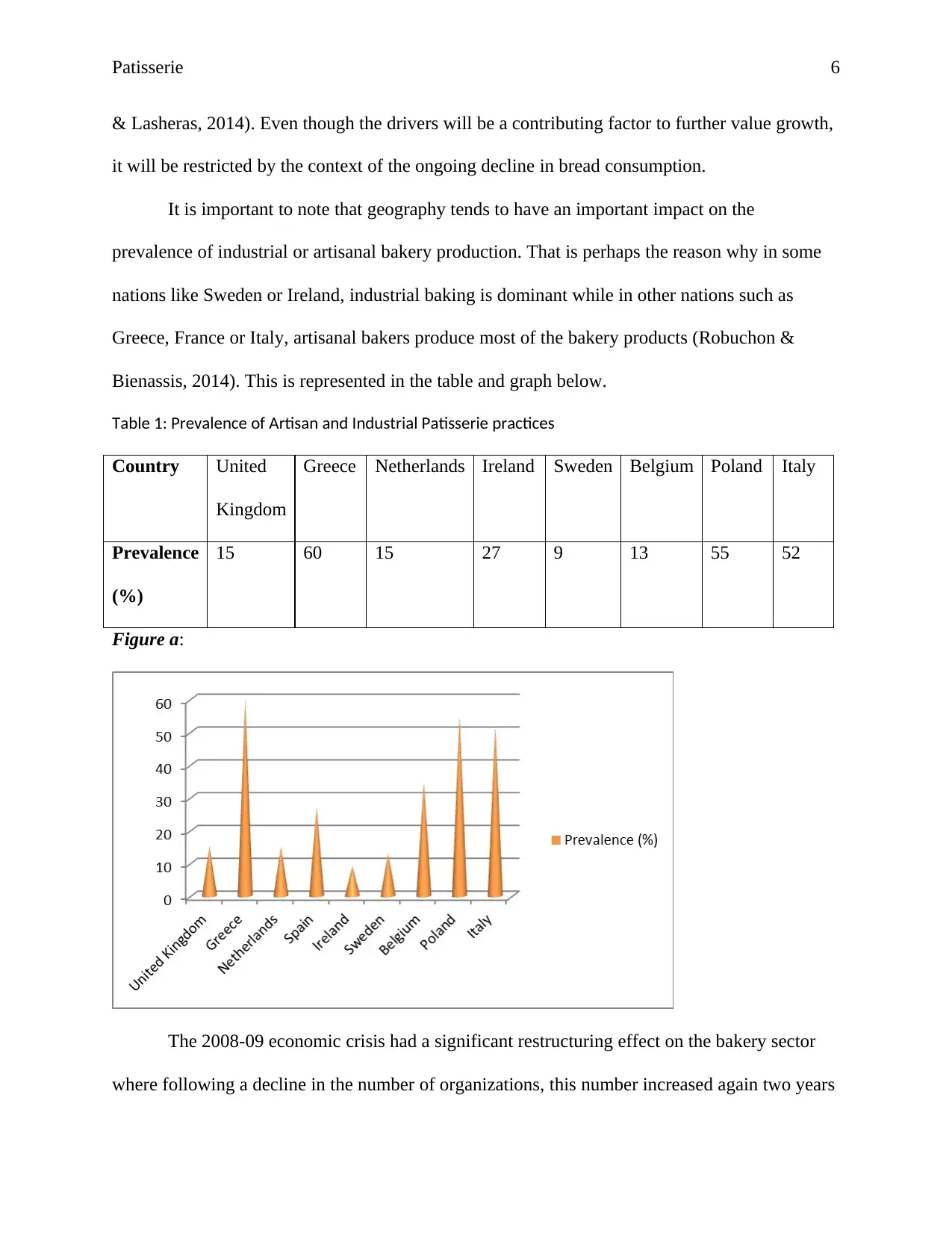
Patisserie 6
& Lasheras, 2014). Even though the drivers will be a contributing factor to further value growth,
it will be restricted by the context of the ongoing decline in bread consumption.
It is important to note that geography tends to have an important impact on the
prevalence of industrial or artisanal bakery production. That is perhaps the reason why in some
nations like Sweden or Ireland, industrial baking is dominant while in other nations such as
Greece, France or Italy, artisanal bakers produce most of the bakery products (Robuchon &
Bienassis, 2014). This is represented in the table and graph below.
Table 1: Prevalence of Artisan and Industrial Patisserie practices
Country United
Kingdom
Greece Netherlands Ireland Sweden Belgium Poland Italy
Prevalence
(%)
15 60 15 27 9 13 55 52
Figure a:
The 2008-09 economic crisis had a significant restructuring effect on the bakery sector
where following a decline in the number of organizations, this number increased again two years
& Lasheras, 2014). Even though the drivers will be a contributing factor to further value growth,
it will be restricted by the context of the ongoing decline in bread consumption.
It is important to note that geography tends to have an important impact on the
prevalence of industrial or artisanal bakery production. That is perhaps the reason why in some
nations like Sweden or Ireland, industrial baking is dominant while in other nations such as
Greece, France or Italy, artisanal bakers produce most of the bakery products (Robuchon &
Bienassis, 2014). This is represented in the table and graph below.
Table 1: Prevalence of Artisan and Industrial Patisserie practices
Country United
Kingdom
Greece Netherlands Ireland Sweden Belgium Poland Italy
Prevalence
(%)
15 60 15 27 9 13 55 52
Figure a:
The 2008-09 economic crisis had a significant restructuring effect on the bakery sector
where following a decline in the number of organizations, this number increased again two years
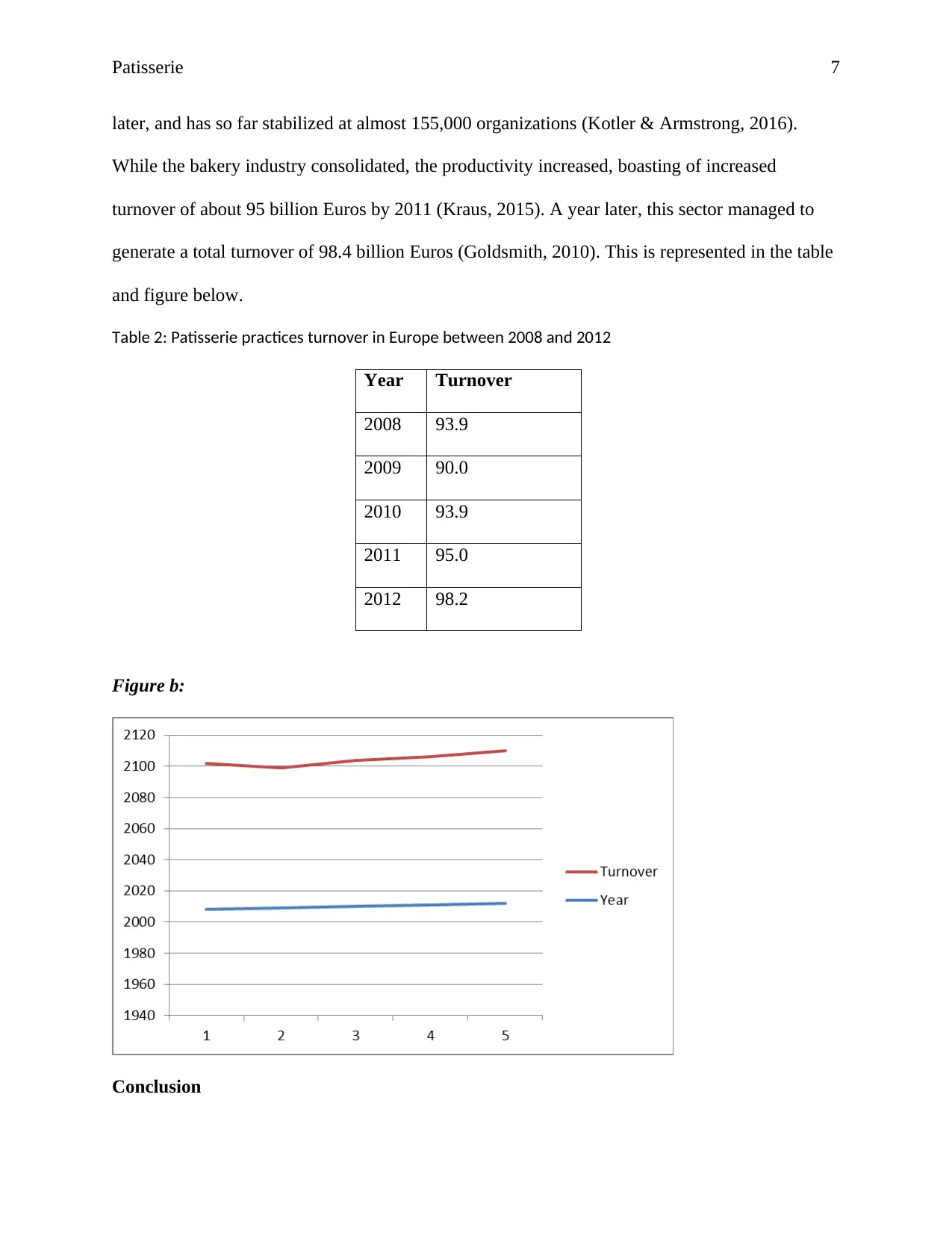
Patisserie 7
later, and has so far stabilized at almost 155,000 organizations (Kotler & Armstrong, 2016).
While the bakery industry consolidated, the productivity increased, boasting of increased
turnover of about 95 billion Euros by 2011 (Kraus, 2015). A year later, this sector managed to
generate a total turnover of 98.4 billion Euros (Goldsmith, 2010). This is represented in the table
and figure below.
Table 2: Patisserie practices turnover in Europe between 2008 and 2012
Year Turnover
2008 93.9
2009 90.0
2010 93.9
2011 95.0
2012 98.2
Figure b:
Conclusion
later, and has so far stabilized at almost 155,000 organizations (Kotler & Armstrong, 2016).
While the bakery industry consolidated, the productivity increased, boasting of increased
turnover of about 95 billion Euros by 2011 (Kraus, 2015). A year later, this sector managed to
generate a total turnover of 98.4 billion Euros (Goldsmith, 2010). This is represented in the table
and figure below.
Table 2: Patisserie practices turnover in Europe between 2008 and 2012
Year Turnover
2008 93.9
2009 90.0
2010 93.9
2011 95.0
2012 98.2
Figure b:
Conclusion
Paraphrase This Document
Need a fresh take? Get an instant paraphrase of this document with our AI Paraphraser
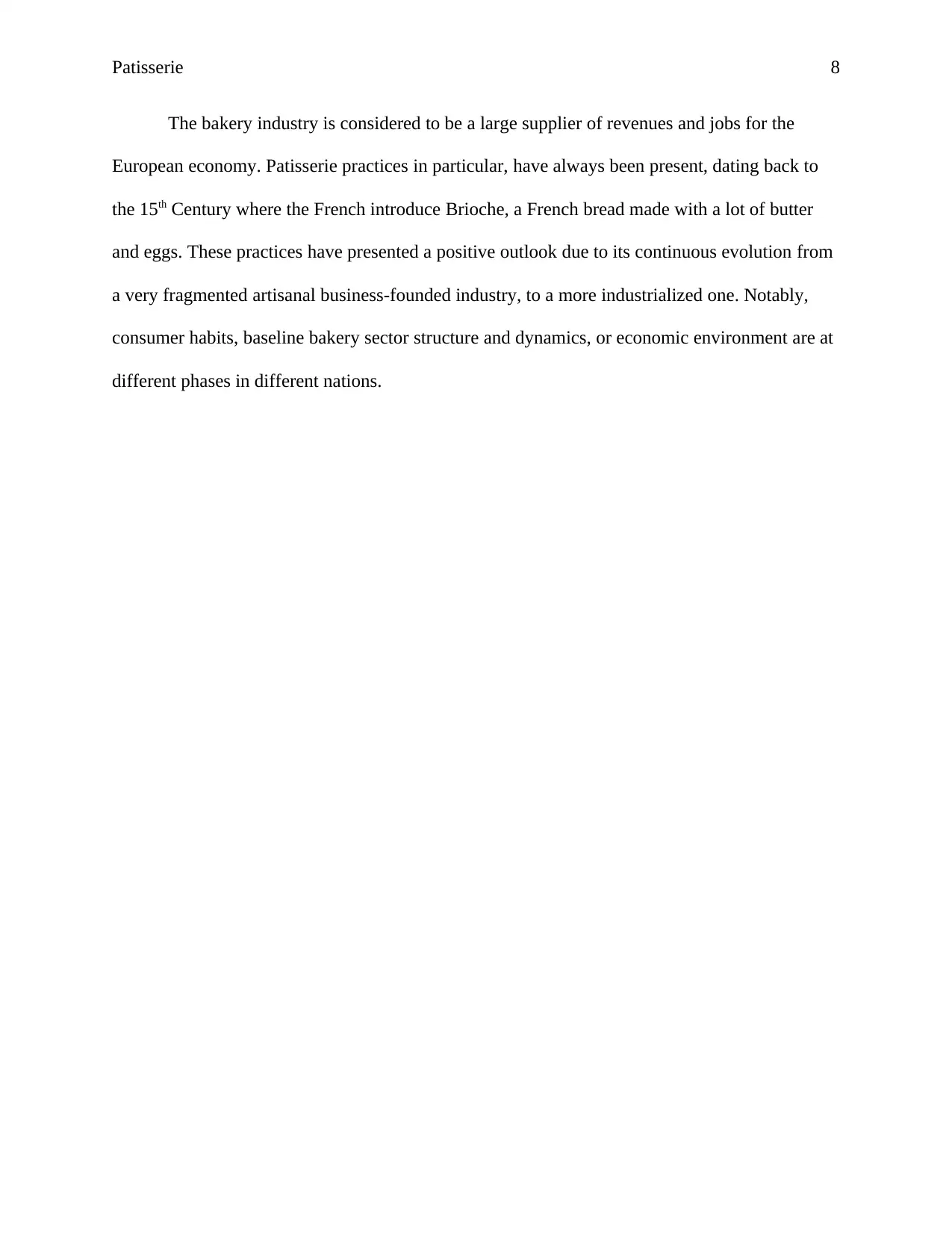
Patisserie 8
The bakery industry is considered to be a large supplier of revenues and jobs for the
European economy. Patisserie practices in particular, have always been present, dating back to
the 15th Century where the French introduce Brioche, a French bread made with a lot of butter
and eggs. These practices have presented a positive outlook due to its continuous evolution from
a very fragmented artisanal business-founded industry, to a more industrialized one. Notably,
consumer habits, baseline bakery sector structure and dynamics, or economic environment are at
different phases in different nations.
The bakery industry is considered to be a large supplier of revenues and jobs for the
European economy. Patisserie practices in particular, have always been present, dating back to
the 15th Century where the French introduce Brioche, a French bread made with a lot of butter
and eggs. These practices have presented a positive outlook due to its continuous evolution from
a very fragmented artisanal business-founded industry, to a more industrialized one. Notably,
consumer habits, baseline bakery sector structure and dynamics, or economic environment are at
different phases in different nations.
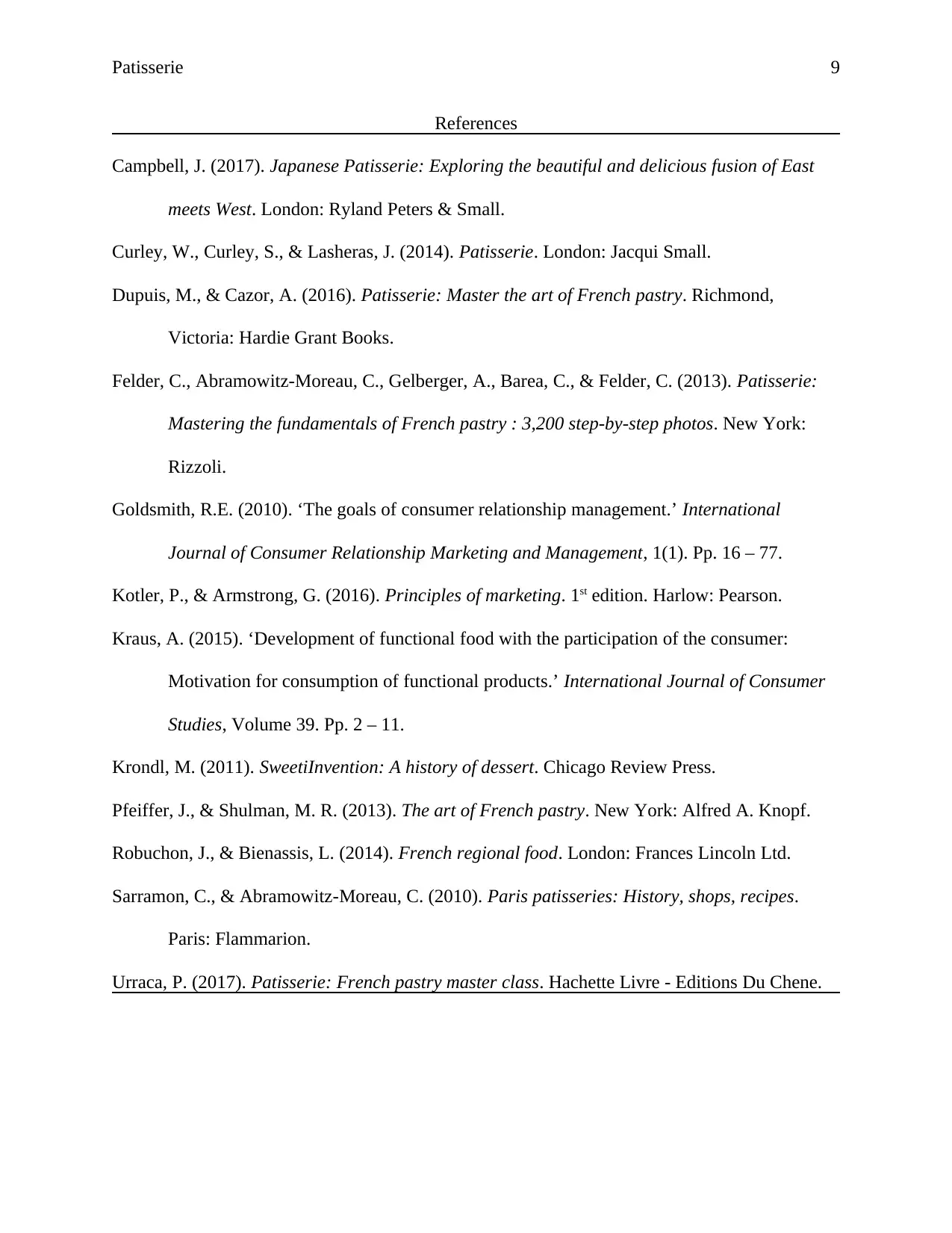
Patisserie 9
References
Campbell, J. (2017). Japanese Patisserie: Exploring the beautiful and delicious fusion of East
meets West. London: Ryland Peters & Small.
Curley, W., Curley, S., & Lasheras, J. (2014). Patisserie. London: Jacqui Small.
Dupuis, M., & Cazor, A. (2016). Patisserie: Master the art of French pastry. Richmond,
Victoria: Hardie Grant Books.
Felder, C., Abramowitz-Moreau, C., Gelberger, A., Barea, C., & Felder, C. (2013). Patisserie:
Mastering the fundamentals of French pastry : 3,200 step-by-step photos. New York:
Rizzoli.
Goldsmith, R.E. (2010). ‘The goals of consumer relationship management.’ International
Journal of Consumer Relationship Marketing and Management, 1(1). Pp. 16 – 77.
Kotler, P., & Armstrong, G. (2016). Principles of marketing. 1st edition. Harlow: Pearson.
Kraus, A. (2015). ‘Development of functional food with the participation of the consumer:
Motivation for consumption of functional products.’ International Journal of Consumer
Studies, Volume 39. Pp. 2 – 11.
Krondl, M. (2011). SweetiInvention: A history of dessert. Chicago Review Press.
Pfeiffer, J., & Shulman, M. R. (2013). The art of French pastry. New York: Alfred A. Knopf.
Robuchon, J., & Bienassis, L. (2014). French regional food. London: Frances Lincoln Ltd.
Sarramon, C., & Abramowitz-Moreau, C. (2010). Paris patisseries: History, shops, recipes.
Paris: Flammarion.
Urraca, P. (2017). Patisserie: French pastry master class. Hachette Livre - Editions Du Chene.
References
Campbell, J. (2017). Japanese Patisserie: Exploring the beautiful and delicious fusion of East
meets West. London: Ryland Peters & Small.
Curley, W., Curley, S., & Lasheras, J. (2014). Patisserie. London: Jacqui Small.
Dupuis, M., & Cazor, A. (2016). Patisserie: Master the art of French pastry. Richmond,
Victoria: Hardie Grant Books.
Felder, C., Abramowitz-Moreau, C., Gelberger, A., Barea, C., & Felder, C. (2013). Patisserie:
Mastering the fundamentals of French pastry : 3,200 step-by-step photos. New York:
Rizzoli.
Goldsmith, R.E. (2010). ‘The goals of consumer relationship management.’ International
Journal of Consumer Relationship Marketing and Management, 1(1). Pp. 16 – 77.
Kotler, P., & Armstrong, G. (2016). Principles of marketing. 1st edition. Harlow: Pearson.
Kraus, A. (2015). ‘Development of functional food with the participation of the consumer:
Motivation for consumption of functional products.’ International Journal of Consumer
Studies, Volume 39. Pp. 2 – 11.
Krondl, M. (2011). SweetiInvention: A history of dessert. Chicago Review Press.
Pfeiffer, J., & Shulman, M. R. (2013). The art of French pastry. New York: Alfred A. Knopf.
Robuchon, J., & Bienassis, L. (2014). French regional food. London: Frances Lincoln Ltd.
Sarramon, C., & Abramowitz-Moreau, C. (2010). Paris patisseries: History, shops, recipes.
Paris: Flammarion.
Urraca, P. (2017). Patisserie: French pastry master class. Hachette Livre - Editions Du Chene.
1 out of 9
Your All-in-One AI-Powered Toolkit for Academic Success.
+13062052269
info@desklib.com
Available 24*7 on WhatsApp / Email
![[object Object]](/_next/static/media/star-bottom.7253800d.svg)
Unlock your academic potential
© 2024 | Zucol Services PVT LTD | All rights reserved.